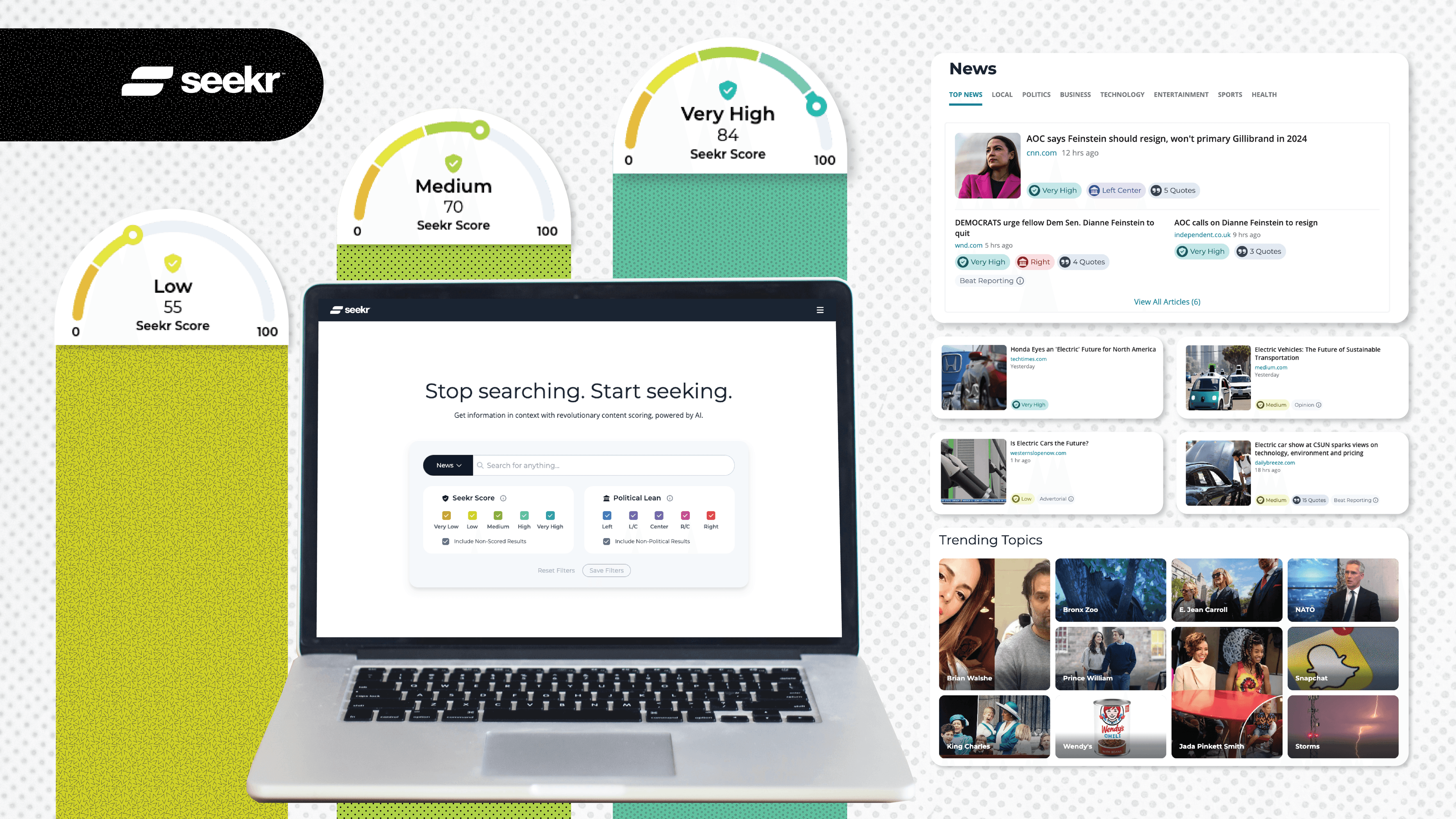

The accuracy of the Seekr Score is continuously

Seekr was built with one mission: to streamline access to the most reliable information online. As a result, we’re always listening and refining to ensure every aspect of the experience on Seekr.com is delivering on our promise. Afterall, clarity is key.
In this update, our number one goal was to make sure the Seekr Score was easy to understand and use, which dictated many of the biggest changes. We also prioritized an experience that made news discovery simple and customizable. And to top it all off, we gave ourselves a pretty nice makeover!
After you’ve had a chance to experience the updates, please tell us what you think in this short survey.
Update Priority #1: Seekr Score Understanding & Ease of Use
Very low – Very high bucket sorting:
The Seekr Score is sorted into five levels of reliability from very low to very high. This helps to align the number with a meaning and offer perspective at a glance.
Numeric representation:
The Seekr Score is still represented as a number, which you can view on the score breakdown popup. However, it is now a number from 1 to 100 rather than 1 to 10. This helps showcase the granularity of the evaluation. Articles can exist in the same bucket but still have different scores.
Color meaning:
Score buckets from very low to very high are also signified by color from orange to teal, which is now visible on the scored search results for quick scanning and processing.
Score explanations:
We wanted to be transparent about what “reliable” means and how that impacts the Seekr Score, so we wrote definitions for each reliability bucket. Of course, articles are scored on an individual basis, and each impacted differently, but the definitions are intended to provide a general guideline. See below:
Very High: Article uses straight reporting, meaning it tells us what happened with very little influential, predictive, or opinionated terminology associated with the Seekr Score Factors. It may even be a primary source for other publications, which may be evident in the byline. When articles don’t stray from the most essential information (who, what, when), it’s less likely that our AI will detect negative score factors. This is what an A+ looks like! (Note: Opinion pieces are expected to have some subjectivity. That does impact the score; however, less severely than other article types such as beat reporting.)
High: Article uses straight reporting, but our AI may be detecting some analysis terminology via the Score Factors . It is common in reporting to use facts to support some assumptions, opinions, predictions to understand the why. Our AI picks up on that but has not detected levels of analysis that indicate the author is straying far from the topic. It’s also possible the problem is simply that there is no author! A missing byline can impact an otherwise high-quality article. Not an A+ but predicted as still quite informative and reliable.
Medium: This article is sprinkled with generally informative useful statements; however, it’s not considered an authoritative source. Here’s why: it could lack a byline and/or our AI is detecting levels of analysis terminology that could indicate attempts to persuade, a bias, or deviation from the main topic as shown by our Score Factors. It’s not likely a terrible read, but you may want to consider cross-referencing with another article to ensure you’re getting the bigger picture. Not too shabby—but keep your wits about you.
Low: Rather than to inform, this article’s intent may be to misrepresent, draw clicks, or provoke a response. Reader may still find useful information in the article; however, the way the statements are supported is considered sloppy. This article has high amounts of terminology flagged by Seekr Score Factors that demonstrate low-level analysis which are often boldly represented in a headline and throughout the article. Reader be warned.
Very Low: Rather than to inform, the intent of this article is rather extreme in its attempt to support an agenda. The tactics are deceptive with little concern of presenting valid, straight reporting. In short, you deserve much better.
* Seekr AI can detect direct statements but cannot determine the veracity (level of truth) behind those statements. For example, “The sky turned green on Wednesday, April 5th, 2023” is a statement that does not have any opinionated, predictive, or influential language, however it is not true. Seekr does not tell readers what is true or not true.
Update Priority #2: Simple & Customizable News Search & Discovery:
Filters:
Our Filters are now front and center, site wide where appropriate, to quickly and easily customize your search experience. Choose to filter by Seekr Score or by Political Lean. Finding reliable content and comparing perspectives is now easier.
News Search:
The Seekr Search bar defaults to a news search to ensure you’re getting scored content from the start. Don’t fret if that’s not what you’re looking for. The search filters are now built into the search bar, so you can always search for anything at Seekr.
Clusters:
Our top news stories are now featured in clusters of three for more coverage and perspectives at a glance. To dig a little deeper, just click the “See more coverage” button.
We’re excited about our work to support a better-informed society. We hope you’ll take some time to look around and tell us what you think!